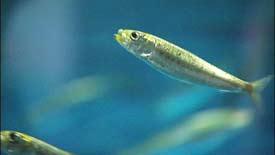Sustainable, abundant, inexpensive, and healthy to eat
Update: April 16, 2010
I recently read the New York Times article, In Maine, Last Sardine Cannery in the U.S. Is Clattering Out about the sardine processing plant that was to close it’s doors, and can it’s last sardine. It’s final day was to be this Sunday, April 18th. Fortunately an undisclosed entity recently made an offer on the facility, great news for the community and the longtime employees of the Stinson Plant in Prospect Harbor, though they have stated they will no longer will be processing sardines.

I spoke with Mike Sutton, Vice President of the Monterey Bay Aquarium, and when I asked about the lack of sources to purchase sardines, he said, “The secret that nobody seems to recognize is that the fishery, which was depleted back in those days has fully recovered, sardines are back, and we’re still fishing the heck out of them, but we don’t eat them anymore. Instead, most of the sardines that we fish today go for livestock feed, or tuna. Increasingly the sardines goes for aquaculture feeds.
“But Americans have stopped eating sardines, and it’s one of the tragedies of seafood today, really, because sardines are among the best possible seafoods for human consumption. Not only are they good for the environment because they are low on the food chain, they’re abundant, but they’re also good for you, good for us! They’re high in Omega 3’s, they’re not contaminated unlike tuna, swordfish, et al. Pregnant women can eat sardines until the cows come home.”
Sutton continued, “we have a new Super Green list on our Seafood Watch program. We’ve always had the Green, Red, and Yellow list; but super Green means good for the environment and good for you. Healthy and environmentally friendly choice. And sardines are at the top of that list.”
He also mentioned the Sardinistas – an underground guerrilla movement to “return the Pacific sardine to the American palate.” A big task for such a small group: himself, a businessman, a fisherman, and a filmmaker. But they are determined. “Like any guerrilla movement it’s an uphill battle. And that’s because most people do not like sardines. [why is that?] I think it’s because they taste fishy. People now, when they think of sardines, they think of a tin of sardines in oil. They don’t smell good, they don’t taste good, people have just gotten used to not liking sardines. We need the mass market to be interested in sardines the way it’s interested in canned tuna. And that’s a long haul.”
In an earlier time, Sutton related, Americans consumed fresh sardines; they were one of the principle foods fed to our World War 1 soldiers. Maybe it’s time to re-enlist the sardine back into the American culinary diet.
From a talk at the recent Cooking For Solutions conference, Dr. Geoff Shester, the Senior Science Manager, Monterey Bay Aquarium’s Sustainable Seafood Initiative describes a sustainably managed fish, high in protein and healthy nutrients, abundant, inexpensive to produce, that could feed a large number of people, affordably. So, what’s the problem?
See related videos: Seafood Watch A program of the Monterey Bay Aquarium began about 10 years ago to help raise consumer awareness and promote business practices to protect the ocean’s fish populations from overfishing, pollution, and native habitat destruction. State of the Oceans Health: In Crisis Alison Barratt, from the Monterey Bay Aquarium’s Seafood Watch program discusses the health of the oceans in relation to native fish populations, and the decline of their ecosystems.
